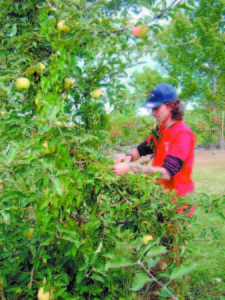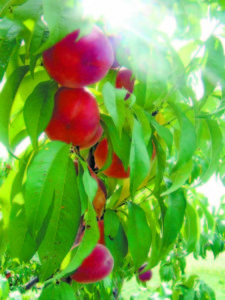Behold the life cycle of apples: Year in an orchard

WEEDING VINES — Pietree staffer Jonathan Delvecchio, 19, of Bridgton, weeds vines from the Ginger Gold apple trees. (De Busk Photo)
By Dawn De Busk
Staff Writer
SWEDEN — Few things are as tempting as ripe fruit picked directly from the tree on which it grew. The promise of being delicious and fresh beckons from the flesh of the fruit.
Apples have been a temptation since Eve plucked one from the tree of knowledge in the Garden of Eden.
At orchards here in Maine, you-pick offerings are very appealing to the public. It’s a chance to combine a shared activity with selecting items typically on a grocery list.
“Pick your own is a wonderful opportunity to introduce people to new apple varieties,†according to Scott Miller, the orchardist at Pietree Orchard in Sweden.
“You-pick is all over the farm. Right now, we are concentrating on the south side. The view is a little bit better. People like to see Mount Washington and Shawnee Peak,†he said.
This week, the pick-your-own apples include: Macintosh, Cortlands, Ginger Golds.
“This is the first time we had Ginger Golds as a pick your own,†Miller said, going into the origins of this variety. “It was found growing on stone wall in an orchard down in Virginia. The farmer’s wife’s name was Ginger and it is gold apple — the rest is history.â€
At Pietree Orchards, there are about 5,000 trees that yield fruit including varieties of apples, peaches, plums and pears.
In an orchard, the tender loving care doesn’t stop when the snow flies. Maintenance is required year-round. In fact, when the tree goes dormant, the staff gets busy with pruning, an activity that lasts about four hours a day for four or five months.
“You prune the trees first that you will miss the least. In other words, you save your most important trees for last,†Miller said. “We like to be done pruning by May. Most years, we finish in April.â€
“Next year’s crops are on the trees waiting to get through the winter until the conditions are right,†he said.
“Once things start to wake up in the spring, we have to take care of wood on the ground. There are a lot of prunings left over from winter. I grind the prunings in place and put them back into the top soil,†Miller said.
 “We start worrying about diseases and insects. We monitor for those and treat when appropriate,†he said.
“We start worrying about diseases and insects. We monitor for those and treat when appropriate,†he said.
“Once the grass starts growing, we keep the grass mowed to decrease competition, and to make it easier for the owls, the hawks and fox to find the mice. The mice will chew the barks of the apple trees during the winter. They can kill a tree,†he said.
“During the summer, we maintain mowing and we continue monitoring for diseases and insects,†he said.
“Also, we try to look at the crop load. If trees have too many apples, we trim the excess. It is not good for the trees to be over cropped so we monitor the crop loads,†he said. “It varies from tree to tree. For example, the Honey Crisp — it is very bad for the trees more so than other variety. It is a fussy apple variety.â€
“The peaches or apples never get any size if we are not thinning the fruit crop out. It is better for our bottom line, too. The people don’t want golf ball size apples; they’d rather have nice-sized apples,†he said.
Although apples are associated with autumn, the spring blossoming is a fine time to be in an orchard. The apple bloom starts out pink and transforms into snowy white.
“The apple bloom this year was around May 21st, which is about average. Pears were a week before that. It is a pleasant environment during the bloom,†Miller said. “Apple blossoms typically take a week, or a week and a half. The petals hang on until they have been pollinated.â€
“We do have hives on the property. They are good all summer long. We rent hives in the springtime during the pollination because there are more blossoms than our bees can handle,†he said.
“It is pretty around here during full bloom, very busy and kind of nice,†he said.
Still, during this cycle, there are a lot of things that could go wrong.
“We could have a frost and ruin the crops. There have been years that it rains all week long. If you don’t have bees, the crops get reduced by bee flights.
Frost is the biggest worry,†Miller said.
There are a number of diseases that get started in the spring. For example apple scab, a fungus, is a concern when the weather is warm and wet for a duration.
“I spend a lot of time looking at the weather,†Miller said.
There are apple varieties, such as the Lodi, that are available as early as July. But most varieties ripen in September.
“Maine Apple Sunday is a time to encourage people to think about apples. By Columbus Day weekend when everyone knows it is apple season, it is over. We have tried to find a Sunday that works well for everybody. Some orchardists wished it started earlier; some orchardists wished it started later. For us in Sweden and Bridgton, it is perfect,†Miller said.
Likewise, the crisp air and sunshine was the perfect weather for Maine Apple Sunday 2018.
“I was grinning ear to ear. I was happy this Sunday morning. It was cold. It felt like fall,†Miller said. “If it was 80 degrees, everyone goes to the beach and no one thinks about apples. The seasons have been getting a little bit warmer. The last few years, we picked apples until the first week in November.â€
Going through the seasons of an apple orchard, late fall is when “things are winding down.â€
“We grind the debris from harvest and mow the orchard one last time. We even grind up the fallen apples. A lot of diseases overwinter in the leaves so if you grind, it helps in springtime,†he said.
Miller has witnessed the apple-tree cycle for quite some time now. He has been growing apples in Bridgton, Waterford, and Sweden for 25 years. It an occupation he does not regret choosing.
“If the weather is nice, I like to be outside. I save deskwork for days I’d rather not be outside,†he said.

